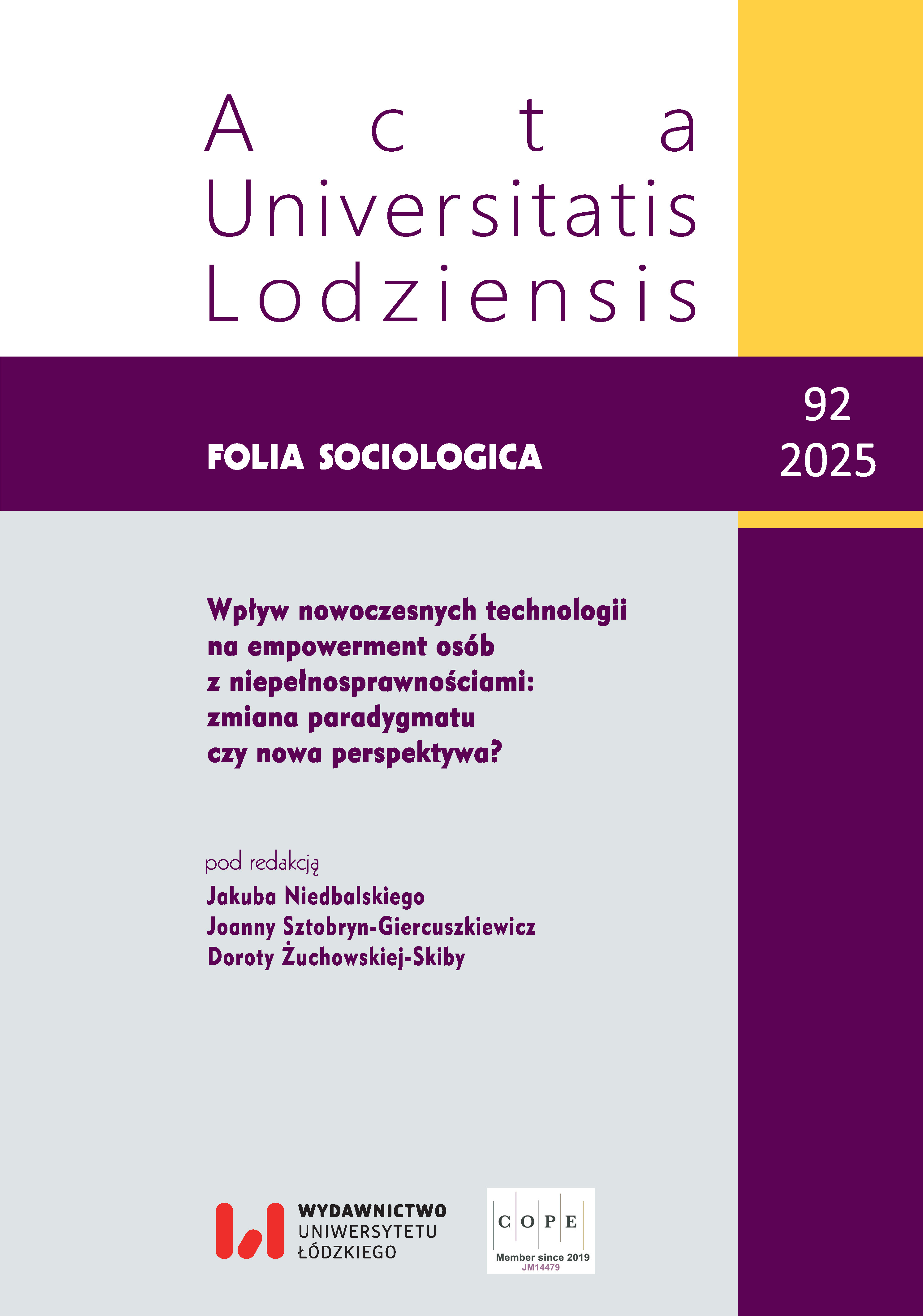VR jako narzędzie empatii? Prezentacje niepełnosprawności i osób z niepełnosprawnościami w doświadczeniach wirtualnych
DOI:
https://doi.org/10.18778/0208-600X.92.08Słowa kluczowe:
wirtualna rzeczywistość, niepełnosprawność, empatia, stereotypy, reprezentacja społecznaAbstrakt
Rzeczywistość wirtualna (VR) odsłania niezwykłe możliwości w zakresie badania i zrozumienia doświadczeń związanych z niepełnosprawnościami. Ta technologia umożliwia prezentowanie niepełnosprawności w sposób sprzyjający zrozumieniu i budowaniu empatii wobec osób z niepełnosprawnościami. Poprzez wirtualne scenariusze, interakcje z postaciami i symulowane sytuacje, VR stara się być narzędziem empatycznym, generując autentyczne przeżycia emocjonalne. Bodźce wizualne, dźwiękowe, a czasami także dotykowe intensyfikują reakcje empatyczne odbiorców. Dzięki starannie zaprojektowanym doświadczeniom VR pozwala użytkownikom zanurzyć się w życie osób z różnymi rodzajami niepełnosprawności.
Celem niniejszego artykułu jest analiza treści prezentowanych w doświadczeniach wirtualnej rzeczywistości (VR) w kontekście przedstawiania niepełnosprawności i osób z niepełnosprawnościami. W badaniach nad VR często podkreśla się jej potencjał jako narzędzia do budowania empatii, jednak równie istotne jest zrozumienie, jak treści te mogą wpływać na postrzeganie niepełnosprawności. Artykuł omawia zarówno pozytywne aspekty VR, jak i ryzyka związane z utrwalaniem stereotypów. Analiza przeprowadzona na wybranych przykładach doświadczeń VR pozwala na ocenę, na ile te technologie przyczyniają się do lepszego zrozumienia sytuacji osób z niepełnosprawnościami.
Bibliografia
Abrams K.B., Wilson A., Hernandez T.D., Choate A. (2024), Virtual Reality-based simulated hallucinations to enhance empathy toward individuals with schizophrenia, „The Journal of Nervous and Mental Disease”, t. 212, s. 312–316.
Google Scholar
DOI: https://doi.org/10.1097/NMD.0000000000001772
Ahn S.J., Le A.M., Bailenson J. (2013), The effect of embodied experiences on self-other merging, attitude, and helping behaviour, „Media Psychology”, t. 16, s. 7–38.
Google Scholar
DOI: https://doi.org/10.1080/15213269.2012.755877
Barbot B., Kaufman J.C. (2020), What makes immersive virtual reality the ultimate empathy machine? Discerning the underlying mechanisms of change, „Computers in Human Behavior”, t. 111, s. 106431–106440.
Google Scholar
DOI: https://doi.org/10.1016/j.chb.2020.106431
Bloom P. (2017), Against Empathy: The Case for Rational Compassion, Random House, New York.
Google Scholar
Bujić M., Salminen M., Macey J., Hamari J. (2020), „Empathy machine”: How virtual reality affects human rights attitudes, „Internet Research”, t. 30(5), s. 1407–1425.
Google Scholar
DOI: https://doi.org/10.1108/INTR-07-2019-0306
Chowdhury T.I., Quarles J. (2022), A wheelchair locomotion interface in a VR disability simulation reduces implicit bias, „IEEE Transactions on Visualization and Computer Graphics”, nr 28, s. 4658–4670.
Google Scholar
DOI: https://doi.org/10.1109/TVCG.2021.3099115
Chowdhury T.I., Ferdous S.M.S., Quarles J. (2019), VR disability simulation reduces implicit bias towards persons with disabilities, „IEEE Transactions on Visualization and Computer Graphics”, nr 27, s. 3079–3090.
Google Scholar
DOI: https://doi.org/10.1109/TVCG.2019.2958332
Cummings J.J., Bailenson J.N. (2016), How immersive is enough? A meta-analysis of the effect of immersive technology on user presence, „Media Psychology”, t. 19(2), s. 272–309.
Google Scholar
DOI: https://doi.org/10.1080/15213269.2015.1015740
Dvash J., Shamay-Tsoory S. (2014), Theory of mind and empathy as multidimensional constructs: Neurological foundations, „Topics in Language Disorders”, t. 34, s. 282–295. https://doi.org/10.1097/TLD.0000000000000040
Google Scholar
DOI: https://doi.org/10.1097/TLD.0000000000000040
Dyer E., Swartzlander B.J., Gugliucci M.R. (2018), Using virtual reality in medical education to teach empathy, „Journal of the Medical Library Association”, t. 106(4), s. 498–500.
Google Scholar
DOI: https://doi.org/10.5195/jmla.2018.518
Farmer H., Maister L. (2017), Putting ourselves in another’s skin: Using the plasticity of self-perception to enhance empathy and decrease prejudice, „Social Justice Research”, t. 30, s. 323–354.
Google Scholar
DOI: https://doi.org/10.1007/s11211-017-0294-1
Hamilton-Giachritsis C., Banakou D., Garcia Quiroga M., Giachritsis C., Slater M. (2018), Reducing risk and improving maternal perspective-taking and empathy using virtual embodiment, „Scientific Reports”, nr 8, s. 2975.
Google Scholar
DOI: https://doi.org/10.1038/s41598-018-21036-2
Herrera F., Bailenson J., Weisz E., Ogle E., Zaki J. (2018), Building long-term empathy: A large-scale comparison of traditional and virtual reality perspective-taking, „PloS One”, nr 13(10), e0204494.
Google Scholar
DOI: https://doi.org/10.1371/journal.pone.0204494
Hirt J., Beer T. (2020), Use and impact of virtual reality simulation in dementia care education: A scoping review, „Nurse Education Today”, nr 84, s. 104207.
Google Scholar
DOI: https://doi.org/10.1016/j.nedt.2019.104207
Huang Y., Ho K.H.M., Christensen M., Wong D.W.C., Wang S., Su J.J., Cheung D.S.K. (2024), Virtual reality-based simulation intervention for enhancing the empathy of informal caregivers of people with dementia: A mixed-methods systematic review, „International Journal of Mental Health Nursing”, t. 33(2), s. 241–258.
Google Scholar
DOI: https://doi.org/10.1111/inm.13240
Kalyanaraman S., Penn D.L., Ivory J.D., Judge A.M. (2010), The virtual doppelganger: Effects of a virtual reality simulator on perceptions of schizophrenia, „The Journal of Nervous and Mental Disease”, t. 198, s. 437–443.
Google Scholar
DOI: https://doi.org/10.1097/NMD.0b013e3181e07d66
Kliteni K., Groten R., Slater M. (2012), The sense of embodiment in virtual reality, „Presence”, t. 21(4), s. 373–387.
Google Scholar
DOI: https://doi.org/10.1162/PRES_a_00124
Lara F., Rueda J. (2021), Virtual reality not for „being someone” but for „being in someone elseʼs shoes”: Avoiding misconceptions in empathy enhancement, „Frontiers in Psychology”, nr 12, 741516. https://doi.org/10.3389/fpsyg.2021.741516
Google Scholar
DOI: https://doi.org/10.3389/fpsyg.2021.741516
Loska W. (2020), Maszyna empatyczna – maszyna opresyjna. Krytyczny przegląd doświadczeń VR, „Nowy Napis Co Tydzień”, nr 77.
Google Scholar
Martingano A.J., Herrera F., Konrath S. (2021), Virtual reality improves emotional but not cognitive empathy: A meta-analysis, „Technology, Mind, and Behavior”, nr 2(1). https://doi.org/10.1037/tmb0000034
Google Scholar
DOI: https://doi.org/10.1037/tmb0000034
Milk C. (2015), How virtual reality can create the ultimate empathy machine, TED Talk, https://www.youtube.com/watch?v=iXHil1TPxvA (dostęp: 30.06.2023).
Google Scholar
Peña J., Blackburn K. (2013), The priming effects of virtual environments on interpersonal perceptions and behaviors, „Journal of Communication”, t. 63(4), s. 703–720.
Google Scholar
DOI: https://doi.org/10.1111/jcom.12043
Pinto-Coelho L., Laska-Leśniewicz A., Pereira E.T., Sztobryn-Giercuszkiewicz J. (2023), Inclusion and adaptation beyond disability: Using virtual reality to foster empathy, „Medycyna Pracy. Workersʼ Health and Safety”, t. 74(3), s. 171–185.
Google Scholar
DOI: https://doi.org/10.13075/mp.5893.01386
Ramirez E.J., Elliot M., Milam P. (2021), What itʼs like to be a ____: Why itʼs (often) unethical to use VR as an empathy nudging tool, „Ethics and Information Technology”. https://doi.org/10.1007/s10676-021-09594-y
Google Scholar
DOI: https://doi.org/10.1007/s10676-021-09594-y
Sarge M.A., Kim H.S., Velez J.A. (2020), An Auti-Sim intervention: The role of perspective taking in combating public stigma with virtual simulations, „Cyberpsychology, Behavior, and Social Networking”, t. 23(1), s. 41–51.
Google Scholar
DOI: https://doi.org/10.1089/cyber.2019.0678
Shin D. (2018), Empathy and embodied experience in virtual environment: To what extent can virtual reality stimulate empathy and embodied experience?, „Computers in Human Behavior”, t. 78, s. 64–73.
Google Scholar
DOI: https://doi.org/10.1016/j.chb.2017.09.012
Shin D., Biocca F. (2018), Exploring immersive experience in journalism, „New Media & Society”, t. 20(8), s. 2800–2823.
Google Scholar
DOI: https://doi.org/10.1177/1461444817733133
Singer T., Klimecki O. (2014) Empathy and compassion, „Current Biology”, nr 24, s. R875–R878. https://doi.org/10.1016/j.cub.2014.06.054
Google Scholar
DOI: https://doi.org/10.1016/j.cub.2014.06.054
Slater M., Sanchez-Vives M.V. (2016), Enhancing our lives with immersive virtual reality, „Frontiers in Robotics and AI”, nr 3, s. 74.
Google Scholar
DOI: https://doi.org/10.3389/frobt.2016.00074
Slater P., Hasson F., Gillen P., Gallen A., Parlour R. (2019), Virtual simulation training: Imaged experience of dementia, „International Journal of Older People Nursing”, t. 14(3), e12243.
Google Scholar
DOI: https://doi.org/10.1111/opn.12243
Tay J.L., Xie H., Sim K. (2023), Effectiveness of Augmented and Virtual Reality-based interventions in improving knowledge, attitudes, empathy and stigma regarding people with mental illnesses – A scoping review, „Journal of Personalized Medicine”, t. 13(1), s. 112.
Google Scholar
DOI: https://doi.org/10.3390/jpm13010112
Topping M., Douglas J.M., Winkler D. (2020), Factors that influence the quality of paid support for adults with acquired neurological disability: Scoping review and thematic synthesis, „Disability and Rehabilitation”, t. 1–19, s. 2482–2499.
Google Scholar
DOI: https://doi.org/10.1080/09638288.2020.1830190
Trevena L., Paay J., McDonald R. (2024), VR interventions aimed to induce empathy: A scoping review, „Virtual Reality”, t. 28(2), s. 80.
Google Scholar
DOI: https://doi.org/10.1007/s10055-024-00946-9
Ventura S., Badenes-Ribera L., Herrero R., Cebolla A., Galiana L., Baños R. (2020), Virtual reality as a medium to elicit empathy: A meta-analysis, „Cyberpsychology, Behavior, and Social Networking”, t. 23(10), s. 667–676.
Google Scholar
DOI: https://doi.org/10.1089/cyber.2019.0681
Wijma E.M., Veerbeek M.A., Prins M., Pot A.M., Willemse B.M. (2018), A virtual reality intervention to improve the understanding and empathy for people with dementia in informal caregivers: Results of a pilot study, „Aging and Mental Health”, t. 22(9), s. 1115–1123.
Google Scholar
DOI: https://doi.org/10.1080/13607863.2017.1348470
Wilding C., Young K., Cummins C., Bowler C., Dean T., Lakhani A., Blackberry I. (2023), Virtual reality to foster empathy in disability workers: A feasibility study during COVID-19, „Journal of Applied Research in Intellectual Disabilities”, t. 36(1), s. 132–142.
Google Scholar
DOI: https://doi.org/10.1111/jar.13042
„A Walk Through Dementia”, https://www.awalkthroughdementia.org/ (dostęp: 15.02.2025).
Google Scholar
„Blind”, https://gamefinity.pl/produkt/blind-vr-ps4-1 (dostęp: 15.02.2025).
Google Scholar
„Notes on Blindness: Into Darkness, https://www.meta.com/pl-pl/experiences/1946326588770583/ (dostęp: 15.02.2025).
Google Scholar
„Synapsis: Mój pierwszy dzień w pracy”, http://archiwum2017.docsag.pl/pl/movies/pierwszy-dzienw-pracy/?dist=warszawa (dostęp: 15.02.2025).
Google Scholar
„Wheelchair Simulator VR”, https://store.steampowered.com/app/841120/Wheelchair_Simulator_VR/ (dostęp: 15.02.2025).
Google Scholar
Opublikowane
Jak cytować
Numer
Dział
Licencja

Utwór dostępny jest na licencji Creative Commons Uznanie autorstwa – Użycie niekomercyjne – Bez utworów zależnych 4.0 Międzynarodowe.










